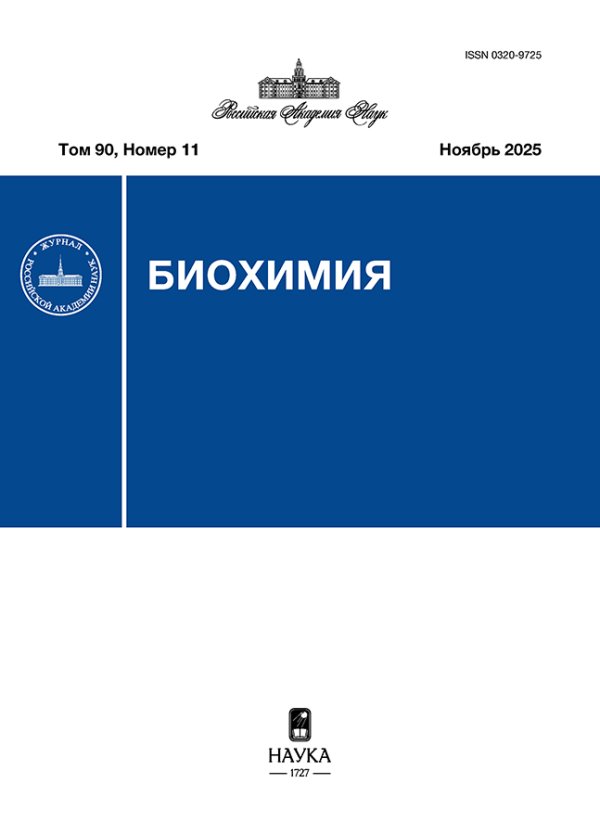Глутаредоксин 1 эволюционно древней гидры: свойства фермента и его возможные внутриклеточные функции
- Авторы: Perween N.1,2, Pekhale K.1, Haval G.1,3, Bose G.S1, Mittal S.P.1, Ghaskadbi S.4, Ghaskadbi S.S1
-
Учреждения:
- Savitribai Phule Pune University
- M.C.E. Society’s Abeda Inamdar Senior College
- Abasaheb Garware College
- Agharkar Research Institute
- Выпуск: Том 88, № 5 (2023)
- Страницы: 817-831
- Раздел: Статьи
- URL: https://journals.rcsi.science/0320-9725/article/view/144675
- DOI: https://doi.org/10.31857/S0320972523050093
- EDN: https://elibrary.ru/AYQWOQ
- ID: 144675
Цитировать
Полный текст
Аннотация
Ключевые слова
Об авторах
N. Perween
Savitribai Phule Pune University;M.C.E. Society’s Abeda Inamdar Senior College
Email: sghaskadbi@gmail.com
Pune 411007, India;Pune 411001, India
K. Pekhale
Savitribai Phule Pune University
Email: sghaskadbi@gmail.com
Pune 411007, India
G. Haval
Savitribai Phule Pune University;Abasaheb Garware College
Email: sghaskadbi@gmail.com
Pune 411007, India;Pune 411004, India
G. S Bose
Savitribai Phule Pune University
Email: sghaskadbi@gmail.com
Pune 411007, India
S. P.K Mittal
Savitribai Phule Pune University
Email: sghaskadbi@gmail.com
Pune 411007, India
S. Ghaskadbi
Agharkar Research Institute
Email: sghaskadbi@gmail.com
Pune 411004, India
S. S Ghaskadbi
Savitribai Phule Pune University
Email: sghaskadbi@gmail.com
Pune 411007, India
Список литературы
- Martínez, D. E., Iñiguez, A. R., Percell, K. M., Willner, J. B., Signorovitch, J., and Campbell, R. D. (2010) Phylogeny and biogeography of Hydra (Cnidaria: Hydridae) using mitochondrial and nuclear DNA sequences, Mol. Phylogenet. Evol., 57, 403-410, doi: 10.1016/j.ympev.2010.06.016.
- Bosch, T. C., Anton-Erxleben, F., Hemmrich, G., and Khalturin, K. (2010) The Hydra polyp: nothing but an active stem cell community, Dev. Growth Differ., 52, 15-25, doi: 10.1111/j.1440-169X.2009.01143.x.
- Schaible, R., Sussman, M., and Kramer, B. H. (2014) Aging and potential for self-renewal: hydra living in the age of aging - a mini-review, Gerontology, 60, w548-556, doi: 10.1159/000360397.
- Martínez, D. E. (1998) Mortality patterns suggest lack of senescence in hydra, Exp. Gerontol., 33, 217-225, doi: 10.1016/s0531-5565(97)00113-7.
- Martínez, D. E., and Bridge, D. (2012) Hydra, the everlasting embryo, confronts aging, Int. J. Dev. Biol., 56, 479-487, doi: 10.1387/ijdb.113461dm.
- Hemmrich, G., Khalturin, K., Boehm, A.-M., Puchert, M., Anton-Erxleben, F., Wittlieb, J., Klostermeier, U. C., Rosenstiel, P., Oberg, H.-H., Domazet-Lošo, T., Sugimoto, T., Niwa, H., and Bosch, T. C. G. (2012) Molecular signatures of the three stem cell lineages in hydra and the emergence of stem cell function at the base of multicellularity, Mol. Biol. Evol., 29, 3267-3280, doi: 10.1093/molbev/mss134.
- Boehm, A. M., Khalturin, K., Anton-Erxleben, F., Hemmrich, G., Klostermeier, U. C., Lopez-Quintero, J. A., Oberg, H. H., Puchert, M., Rosenstiel, P., Wittlieb, J., and Bosch, T. C. (2012) FoxO is a critical regulator of stem cell maintenance in immortal Hydra, Proc. Natl. Acad. Sci. USA, 109, 19697-19702, doi: 10.1073/pnas.1209714109.
- Klotz, L. O., Sánchez-Ramos, C., Prieto-Arroyo, I., Urbánek, P., Steinbrenner, H., and Monsalve, M. (2015) Redox regulation of FoxO transcription factors, Redox Biol., 6, 51-72, doi: 10.1016/j.redox.2015.06.019.
- Dash, B., Metz, R., Huebner, H. J., Porter, W., and Phillips, T. D. (2006) Molecular characterization of phospholipid hydroperoxide glutathione peroxidases from Hydra vulgaris, Gene, 381, 1-12, doi: 10.1016/j.gene.2006.04.026.
- Dash, B., Metz, R., Huebner, H. J., Porter, W., and Phillips, T. D. (2007) Molecular characterization of two superoxide dismutases from Hydra vulgaris, Gene, 387, 93-108, doi: 10.1016/j.gene.2006.08.020.
- Dash, B., and Phillips, T. D. (2012) Molecular characterization of a catalase from Hydra vulgaris, Gene, 501, 144-152, doi: 10.1016/j.gene.2012.04.015.
- Perween, N., Pekhale, K., Haval, G., Mittal, S., Ghaskadbi, S., and Ghaskadbi, S. S. (2022) Cloning and characterization of Thioredoxin 1 from the Cnidarian Hydra, J. Biochem., 171, 41-51, doi: 10.1093/jb/mvab092.
- Holmgren, A., Johansson, C., Berndt, C., Lönn, M. E., Hudemann, C., and Lillig, C. H. (2005) Thiol redox control via thioredoxin and glutaredoxin systems, Biochem. Soc. Trans., 33, 1375-1377, doi: 10.1042/bst20051375.
- Wells, W. W., Xu, D. P., Yang, Y. F., and Rocque, P. A. (1990) Mammalian thioltransferase (glutaredoxin) and protein disulfide isomerase have dehydroascorbate reductase activity, J. Biol. Chem., 265, 15361-15364, doi: 10.1016/S0021-9258(18)55401-6.
- Lillig, C. H., Berndt, C., and Holmgren, A. (2008) Glutaredoxin systems, Biochim. Biophys. Acta, 1780, 1304-1317, doi: 10.1016/j.bbagen.2008.06.003.
- Couturier, J., Jacquot, J. P., and Rouhier, N. (2013) Toward a refined classification of class I dithiol glutaredoxins from poplar: biochemical basis for the definition of two subclasses, Front. Plant Sci., 4, 518, doi: 10.3389/fpls.2013.00518.
- Keselman, A., Pulak, R. N., Moyal, K., and Isakov, N. (2011) PICOT: A multidomain protein with multiple functions, ISRN Immunol., 2011, 426095, doi: 10.5402/2011/426095.
- Herrero, E., and de la Torre-Ruiz, M. A. (2007) Monothiol glutaredoxins: a common domain for multiple functions, Cell. Mol. Life Sci., 64, 1518-1530, doi: 10.1007/s00018-007-6554-8.
- Bräutigam, L., Jensen, L. D., Poschmann, G., Nyström, S., Bannenberg, S., Dreij, K., Lepka, K., Prozorovski, T., Montano, S. J., Aktas, O., Uhlén, P., Stühler, K., Cao, Y., Holmgren, A., and Berndt, C. (2013) Glutaredoxin regulates vascular development by reversible glutathionylation of sirtuin 1, Proc. Natl. Acad. Sci. USA, 110, 20057-20062, doi: 10.1073/pnas.1313753110.
- Fernandes, A. P., and Holmgren, A. (2004) Glutaredoxins: glutathione-dependent redox enzymes with functions far beyond a simple thioredoxin backup system, Antioxid. Redox Signal., 6, 63-74, doi: 10.1089/152308604771978354.
- Jeong, D., Kim, J. M., Cha, H., Oh, J. G., Park, J., Yun, S. H., Ju, E. S., Jeon, E. S., Hajjar, R. J., and Park, W. J. (2008) PICOT attenuates cardiac hypertrophy by disrupting calcineurin-NFAT signaling, Circ. Res., 102, 711-719, doi: 10.1161/circresaha.107.165985.
- Madusanka, R. K., Tharuka, M. D. N., Liyanage, D. S., Sirisena, D., and Lee, J. (2020) Role of rockfish (Sebastes schlegelii) glutaredoxin 1 in innate immunity, and alleviation of cellular oxidative stress: Insights into localization, molecular characteristics, transcription, and function, Comp. Biochem. Physiol. B Biochem. Mol. Biol., 243-244, 110432, doi: 10.1016/j.cbpb.2020.110432.
- Wang, J., Boja, E. S., Tan, W., Tekle, E., Fales, H. M., English, S., Mieyal, J. J., and Chock, P. B. (2001) Reversible glutathionylation regulates actin polymerization in A431 cells, J. Biol. Chem., 276, 47763-47766, doi: 10.1074/jbc.C100415200.
- Reddy, P. C., Barve, A., and Ghaskadbi, S. (2011) Description and phylogenetic characterization of common hydra from India, Curr. Sci., 101, 736-738.
- Johnson, M., Zaretskaya, I., Raytselis, Y., Merezhuk, Y., McGinnis, S., and Madden, T. L. (2008) NCBI BLAST: a better web interface, Nucleic Acids Res., 36, W5-W9, doi: 10.1093/nar/gkn201.
- Kumar, S., Stecher, G., Li, M., Knyaz, C., and Tamura, K. (2018) MEGA X: molecular evolutionary genetics analysis across computing platforms, Mol. Biol. Evol., 35, 1547-1549, doi: 10.1093/molbev/msy096.
- Bendtsen, J. D., Nielsen, H., von Heijne, G., and Brunak, S. (2004) Improved prediction of signal peptides: SignalP 3.0, J. Mol. Biol., 340, 783-795, doi: 10.1016/j.jmb.2004.05.028.
- Almagro Armenteros, J. J., Salvatore, M., Emanuelsson, O., Winther, O., von Heijne, G., Elofsson, A., and Nielsen, H. (2019) Detecting sequence signals in targeting peptides using deep learning, Life Sci. Alliance, 2, e201900429, doi: 10.26508/lsa.201900429.
- Rzhetsky, A., and Nei, M. (1993) Theoretical foundation of the minimum-evolution method of phylogenetic inference, Mol. Biol. Evol., 10, 1073-1095, doi: 10.1093/oxfordjournals.molbev.a040056.
- Kruger, N. J. (2009) The Bradford method for protein quantitation, in The Protein Protocols Handbook, pp. 17-24.
- Holmgren, A., and Aslund, F. (1995) Glutaredoxin, in Methods in Enzymology, Academic Press, pp. 283-292.
- Sadhu, S. S., Callegari, E., Zhao, Y., Guan, X., and Seefeldt, T. (2013) Evaluation of a dithiocarbamate derivative as an inhibitor of human glutaredoxin-1, J. Enzyme Inhib. Med. Chem., 28, 456-462, doi: 10.3109/14756366.2011.649267.
- Omeka, W. K. M., Liyanage, D. S., Yang, H., and Lee, J. (2019) Glutaredoxin 2 from big belly seahorse (Hippocampus abdominalis) and its potential involvement in cellular redox homeostasis and host immune responses, Fish Shellfish Immunol., 95, 411-421, doi: 10.1016/j.fsi.2019.09.071.
- Ken, C. F., Chen, I. J., Lin, C. T., Liu, S. M., Wen, L., and Lin, C. T. (2011) Monothiol glutaredoxin cDNA from Taiwanofungus camphorata: a novel CGFS-type glutaredoxin possessing glutathione reductase activity, J. Agric. Food Chem., 59, 3828-3835, doi: 10.1021/jf1048113.
- Martinez, D. E., Dirksen, M. L., Bode, P. M., Jamrich, M., Steele, R. E., and Bode, H. R. (1997) Budhead, a fork head/HNF-3 homologue, is expressed during axis formation and head specification in hydra, Dev. Biol., 192, 523-536, doi: 10.1006/dbio.1997.8715.
- Gupta, A., Sripa, B., and Tripathi, T. (2017) Purification and characterization of two-domain glutaredoxin in the parasitic helminth Fasciola gigantica, Parasitol. Int., 66, 432-435, doi: 10.1016/j.parint.2016.05.005.
- Ströher, E., and Millar, A. H. (2012) The biological roles of glutaredoxins, Biochem. J., 446, 333-348, doi: 10.1042/bj20112131.
- Arnér, E. S., and Holmgren, A. (2000) Physiological functions of thioredoxin and thioredoxin reductase, Eur. J. Biochem., 267, 6102-6109, doi: 10.1046/j.1432-1327.2000.01701.x.
- Berndt, C., Poschmann, G., Stühler, K., Holmgren, A., and Bräutigam, L. (2014) Zebrafish heart development is regulated via glutaredoxin 2 dependent migration and survival of neural crest cells, Redox Biol., 2, 673-678, doi: 10.1016/j.redox.2014.04.012.
- Hashemy, S. I., Johansson, C., Berndt, C., Lillig, C. H., and Holmgren, A. (2007) Oxidation and S-nitrosylation of cysteines in human cytosolic and mitochondrial glutaredoxins: effects on structure and activity, J. Biol. Chem., 282, 14428-14436, doi: 10.1074/jbc.M700927200.
- Lundberg, M., Johansson, C., Chandra, J., Enoksson, M., Jacobsson, G., Ljung, J., Johansson, M., and Holmgren, A. (2001) Cloning and expression of a novel human glutaredoxin (Grx2) with mitochondrial and nuclear isoforms, J. Biol. Chem., 276, 26269-26275, doi: 10.1074/jbc.M011605200.
- Ceylan, S., Seidel, V., Ziebart, N., Berndt, C., Dirdjaja, N., and Krauth-Siegel, R. L. (2010) The dithiol glutaredoxins of african trypanosomes have distinct roles and are closely linked to the unique trypanothione metabolism, J. Biol. Chem., 285, 35224-35237, doi: 10.1074/jbc.M110.165860.
- Fitzgerald, L. A., Zhang, Y., Lewis, G., and Van Etten, J. L. (2009) Characterization of a monothiol glutaredoxin encoded by Chlorella virus PBCV-1, Virus Genes, 39, 418-426, doi: 10.1007/s11262-009-0392-8.
- Gallogly, M. M., Starke, D. W., Leonberg, A. K., Ospina, S. M., and Mieyal, J. J. (2008) Kinetic and mechanistic characterization and versatile catalytic properties of mammalian glutaredoxin 2: implications for intracellular roles, Biochemistry, 47, 11144-11157, doi: 10.1021/bi800966v.
- Sa, J. H., Kim, K., and Lim, C. J. (1997) Purification and characterization of glutaredoxin from Cryptococcus neoformans, Mol. Cells, 7, 655-660.
- Aslund, F., Zheng, M., Beckwith, J., and Storz, G. (1999) Regulation of the OxyR transcription factor by hydrogen peroxide and the cellular thiol-disulfide status, Proc. Natl. Acad. Sci. USA, 96, 6161-6165, doi: 10.1073/pnas.96.11.6161.
- Löfgren, S., Fernando, M. R., Xing, K. Y., Wang, Y., Kuszynski, C. A., Ho, Y. S., and Lou, M. F. (2008) Effect of thioltransferase (glutaredoxin) deletion on cellular sensitivity to oxidative stress and cell proliferation in lens epithelial cells of thioltransferase knockout mouse, Invest. Ophthalmol. Vis. Sci., 49, 4497-4505, doi: 10.1167/iovs.07-1404.
- Mollbrink, A., Jawad, R., Vlamis-Gardikas, A., Edenvik, P., Isaksson, B., Danielsson, O., Stål, P., and Fernandes, A. P. (2014) Expression of thioredoxins and glutaredoxins in human hepatocellular carcinoma: correlation to cell proliferation, tumor size and metabolic syndrome, Int. J. Immunopathol. Pharmacol., 27, 169-183, doi: 10.1177/039463201402700204.
- Liu, X., Jann, J., Xavier, C., and Wu, H. (2015) Glutaredoxin 1 (Grx1) protects human retinal pigment epithelial cells from oxidative damage by preventing AKT glutathionylation, Invest. Ophthalmol. Vis. Sci., 56, 2821-2832, doi: 10.1167/iovs.14-15876.
- Luikenhuis, S., Perrone, G., Dawes, I. W., and Grant, C. M. (1998) The yeast Saccharomyces cerevisiae contains two glutaredoxin genes that are required for protection against reactive oxygen species, Mol. Biol. Cell, 9, 1081-1091, doi: 10.1091/mbc.9.5.1081.
- Gellert, M., Richter, E., Mostertz, J., Kantz, L., Masur, K., Hanschmann, E. M., Ribback, S., Kroeger, N., Schaeffeler, E., Winter, S., Hochgräfe, F., Schwab, M., and Lillig, C. H. (2020) The cytosolic isoform of glutaredoxin 2 promotes cell migration and invasion, Biochim. Biophys. Acta Gen. Subj., 1864, 129599, doi: 10.1016/j.bbagen.2020.129599.
- Li, B., Chen, M., Lu, M., Xin-Xiang, J., Meng-Xiong, P., and Jun-Wu, M. (2018) Glutaredoxin 3 promotes migration and invasion via the Notch signalling pathway in oral squamous cell carcinoma, Free Radic. Res., 52, 390-401, doi: 10.1080/10715762.2018.1435871.
Дополнительные файлы










